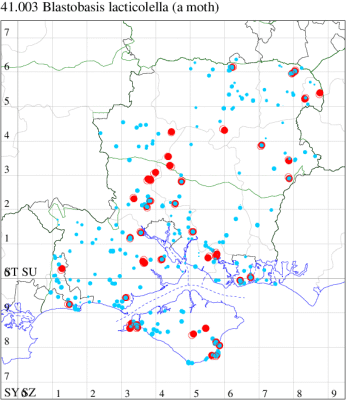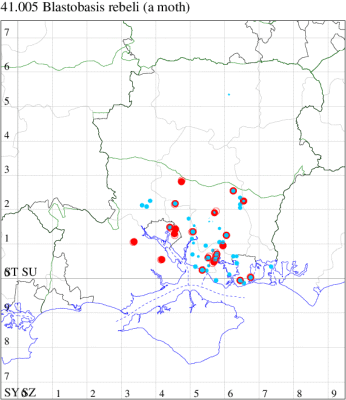2020 Annual Report for: Blastobasidae / Blastobasinae
For species seen in 2020 that had less than or equal to 100 records, full details are included; for more common species, the earliest, latest and highest count by vice-county are shown. The narrative for each species is taken from the main Hantsmoths website, and it is possible that some information on abundance and occurrence can get out of date, as it is impossible to keep up with all changes; however it should give a good introduction to each species. The tables in each species account summarise the previous status, and that for the current year.
For the maps, all records prior to 2020 are shown by a blue dot (the larger the dot, the more recent), with the current year's records shown in red. As previous records are superimposed on any report for 2020, new sites have greater emphasis (i.e. will show as 'more red').
In the species accounts, an asterisk next to a location indicates a new 10km square record; earliest ever dates are highlighted in orange, and latest ever in red. Initials in the species accounts refer to the recorders listed here. Please get in touch if you identify any omissions or errors, in particular if you have records that have yet to be submitted. Details of how to submit records can be found here.
41.002 [B&F: 0873] Blastobasis adustella Walsingham, 1894 - Common
Common in gardens, hedgerows and yew woodland throughout much of the British Isles. Like all Blastobasis sp., a naturalised species which has become well established, but as a native of Madeira, how it reached Britain remains a mystery (MBGBI Vol 4 part 1). In Hampshire and on the Isle of Wight widespread and common. Wingspan 13-19 mm. The adult, which is variable but generally easy to recognise, comes freely to light. The larva feeds on fallen leaves, fresh and decaying vegetable matter, refuse and detritus; there are a few records from Hampshire, from spinnings on flowerheads and in fruits collected in the field.
Update: Larval status update, December 2019.
Records prior to 2020
| Vice County | #Records | #Individuals | First Record | Last Record |
|---|---|---|---|---|
| 10 | 658 | 2830 | 1900 | 2019 |
| 11 | 5138 | 19800 | 1972 | 2019 |
| 12 | 1411 | 5028 | 1976 | 2019 |
2020 records
| Vice County | #Records | #Individuals | Max Quantity |
|---|---|---|---|
| 10 | 47 | 304 | 50 |
| 11 | 357 | 1103 | 25 |
| 12 | 107 | 280 | 13 |

Records by year
Records by week (adult)
Records by week (larval)
Record Summary
VC10: Earliest: Shanklin, 16 Jul, 1 (IOu) Latest: Shanklin, 06 Oct, 1 (IOu) Max count: Shanklin, 09 Aug, 50 (IOu)
VC11: Earliest: Portsmouth, 26 Jun, 1 (IRT) Latest: Southsea, 09 Nov, 1 (JRL) Max count: Hen Wood, 04 Sep, 25 (F.M.G.)
VC12: Earliest: Harestock, 26 Jun, 1 (GRog) Latest: Harestock, 23 Sep, 1 (GRog) Max count: Yateley, 08 Aug, 117 (JHH)
41.003 [B&F: 0874] Blastobasis lacticolella Rebel, 1940 - Common
Common in hedgerows, woodland and gardens throughout much of Britain. Originally a native of Madeira, now fully naturalised, but how it reached Britain remains a mystery (MBGBI Vol 4 part 1). In Hampshire a recent arrival in the county, first being recorded in Portsmouth in 1994, since when it has spread rapidly and is now frequently recorded throughout. On the Isle of Wight increasing in the west of the Island. Wingspan 13-22 mm. Larva feeds on various mosses, dead insects, detritus, decaying vegetable matter, also on seedpods of Tree Lupin and Tansy.
Records prior to 2020
| Vice County | #Records | #Individuals | First Record | Last Record |
|---|---|---|---|---|
| 10 | 278 | 477 | 1999 | 2019 |
| 11 | 1027 | 1274 | 1994 | 2019 |
| 12 | 323 | 452 | 1993 | 2019 |
2020 records
| Vice County | #Records | #Individuals | Max Quantity |
|---|---|---|---|
| 10 | 53 | 110 | 9 |
| 11 | 91 | 113 | 5 |
| 12 | 21 | 30 | 5 |

Records by year
Records by week (adult)
Records by week (larval)
Record Summary
VC10: Earliest: Bonchurch, 21 May, 1 (JHa) Latest: Shanklin, 24 Nov, 2 (IOu) Max count: Shanklin, 24 Jun, 9 (IOu)
VC11: Earliest: Eastleigh, 17 May, 2 (KArb) Latest: Kings Somborne, 16 Nov, 1 (GCE) Max count: Kings Somborne, 16 Nov, 5 (GCE)
VC12: Earliest: Alton, 30 May, 1 (BCA) Latest: Crawley, 17 Nov, 1 (GCE) Max count: Whitehill, 08 Nov, 5 (ASto)
41.004 [B&F: 0873a] Blastobasis vittata (Wollaston, 1858) - Adventive
The third additional species of the genus Blastobasis to be found new to Britain in the last sixteen years. John Langmaid identified two specimens from a collection of B.adustella and B. vittata taken in his Southsea garden trap during 2013.
Records prior to 2020
| Vice County | #Records | #Individuals | First Record | Last Record |
|---|---|---|---|---|
| 11 | 258 | 344 | 2009 | 2019 |
2020 records
| Vice County | #Records | #Individuals | Max Quantity |
|---|---|---|---|
| 11 | 20 | 29 | 3 |

Records by year
Records by week (adult)
Records by week (larval)
Record Details
VC11: Portsmouth, one, 07 Jan; one, 17 Jul; two, 18 Jul; one, 21 Jul; two, 29 Jul; two, 04 Aug; one, 05 Aug; one, 06 Aug; two, 07 Aug; one, 10 Aug; two, 12 Aug; three, 13 Aug; one, 16 Aug; one, 28 Aug; one, 14 Sep; three, 20 Oct; one, 21 Oct; one, 22 Oct; one, 17 Nov (IRT); Southsea, one, 09 Oct (JGe); one, 08 Nov; one, 09 Nov; one, 20 Nov (JRL)
41.0041 [B&F: 0873b] Blastobasis maroccanella Amsel, 1952 - Migrant/Adventive
The specimens that have been assigned to this species in England have been shown to be small, dark, indistinctly marked vittata (Dickson, Langmaid and Thirlwell, 2022: Ent. Rec. J. Var. 134: 116-120) and has now been removed from the British list.
Identified by John Langmaid from well over 100 B. adustella and ten B. vittata during the course of 2013 from his Southsea, Hampshire trap. Two, caught in July and November, proved to be B. maroccanella. The type series were bred from grapes, pea pods and decaying wood, so it is remarkably polyphagous. Known from Madeira, the Azores, Morocco, and the Iberian peninsula, and widely distributed throughout Macaronesia and the western Mediterranean. Has also been introduced to California, USA.
Records prior to 2020
| Vice County | #Records | #Individuals | First Record | Last Record |
|---|---|---|---|---|
| 11 | 4 | 4 | 2013 | 2018 |
2020 records
| Vice County | #Records | #Individuals | Max Quantity |
|---|---|---|---|
| 11 | 1 | 1 | 1 |

Records by year
Records by week (adult)
Records by week (larval)
Record Details
VC11: Portsmouth*, one, gen det, 09 Nov (IRT)
41.005 [B&F: 0875a] Blastobasis rebeli Karsholt & Sinev, 2004 - Adventive
Naturalised through accidental introduction. Originally a native of Madeira, now naturalised, but how it reached Britain remains a mystery. The first British specimen was taken in Hampshire at mercury-vapour light on 17 July 1998 near Bishop's Waltham in a meadow between a housing estate and a stream bordered by an area of damp woodland. A further two were found at the same locality on 27 July 2001, proving that the species is breeding there, and the species has subsequently spread in range to be one of the more common micro-moths in southern Hampshire, now reaching into the north, and reached the Isle of Wight in 2022.
Records prior to 2020
| Vice County | #Records | #Individuals | First Record | Last Record |
|---|---|---|---|---|
| 11 | 349 | 1086 | 1998 | 2019 |
| 12 | 1 | 1 | 2009 | 2009 |
2020 records
| Vice County | #Records | #Individuals | Max Quantity |
|---|---|---|---|
| 11 | 98 | 242 | 15 |

Records by year
Records by week (adult)
Records by week (larval)
Record Summary
VC11: Earliest: Fareham, 28 Jun, 1 (MLO) Latest: Fareham, 30 Aug, 1 (KJW) Max count: Hilltop, The Hangers, 01 Aug, 15 (SI)